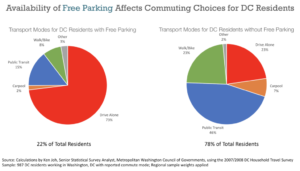Let’s make our streets safer by putting the transportation people in charge of traffic cameras
Opinion by Cheryl Cort, Coalition for Smarter Growth, in www.GreaterGreaterWashington.org
Here’s one of the changes proposed by DC Mayor Muriel Bowser in her budget to fix dangerous streets: Transfer photo enforcement from the Metropolitan Police Department (MPD) to the District Department of Transportation (DDOT). In the wake of so many tragic deaths on our streets, the mayor’s proposed transfer of photo enforcement to DDOT is one of a number of actions she can take to make our streets safer. Whether the DC Council will support this transfer will be determined in the next two weeks in the final budget deliberations and vote.
Traffic cameras can be an effective approach for discouraging dangerous behavior by drivers. By placing oversight of this tool with the agency responsible for managing our streets, automated traffic enforcement could more effectively improve safety. Traffic cameras are helping now, but they could be used much more strategically if DDOT is able to integrate them into its safety programs.
While there’s good precedent for Departments of Transportation administering automated traffic enforcement—New York City and Chicago are examples—DC Council Transportation and Environment Committee (T&E) chair Mary Cheh (Ward 3) is skeptical, and wants to keep photo enforcement where it is, with the police. We at the Coalition for Smarter Growth along with our partners think this would mean a missed opportunity to make our streets safer.
Why would street safety improve if DDOT manages automated traffic enforcement?
DDOT is uniquely positioned to use automated traffic enforcement to bolster its safety programs, like Vision Zero and traffic calming. Unlike MPD, DDOT can use photo enforcement to assess the safety performance of corridors and intersections and make changes that prevent dangerous behavior.
The city’s high number of traffic deaths this year point to the shortcomings to date in DDOT’s efforts to build safe roads, and better utilization of traffic cameras is no substitute for the essential work of street redesign. But bringing the powerful tool of automated traffic enforcement into DDOT’s toolkit is a part of the solution.
In addition to the opportunity to better integrate photo enforcement with DDOT’s other safety tools, the agency is also planning to deploy traffic cameras to enforce bus lane compliance. While DC lags far behind other cities in deployment of dedicated bus lanes, starting this year, the District will establish dedicated bus lanes on H and I Streets downtown as a summer pilot. We also hope to finally see the 16th Street bus lanes, and later the implementation of the K Street redesign with dedicated bus lanes.
But bus lanes need to be enforced, and DC’s record of enforcement hasn’t been great (e.g. 7th and 9th Streets downtown). Given everything on MPD’s plate, getting sufficient attention from MPD to deploy and fine-tune new automated traffic enforcement for bus lanes seems challenging at best. On the other hand, DDOT has a direct interest in using photo enforcement to ensure that bus lanes are successful, move more people, and improve accessibility in the city.
Critics of photo enforcement have often charged that cameras are more about revenue generation than preventing dangerous behavior. Vesting DDOT with the responsibility for using traffic cameras as part of their management of roadway safety gives us an opportunity to ask for greater accountability. With the transfer of traffic cameras sought by the Mayor, the DC Council can insist that DDOT use its data collection and photo enforcement results to act more quickly to fix streets and intersections that show risks outside the norm.
The traffic camera debate is playing out right now
The DC Council and the Bowser administration seek to make good on the promise of Vision Zero. That’s why the Washington Area Bicyclist Association, Coalition for Smarter Growth, and DC Sustainable Transportation, along with Councilmember Charles Allen (Ward 6), DDOT, and the mayor want traffic cameras shifted to DDOT to improve street safety. The debate is playing out right now in the final budget deliberations, and involves a split between two committee chairs.
Cheh wants the MPD to continue to administer automated traffic enforcement, and is not accepting the Mayor’s budget provision transferring automated enforcement to DDOT and under her committee’s oversight. Allen, who chairs the Committee on Public Safety and the Judiciary, supports the transfer to DDOT and does not want to accept the funds back into MPD’s budget. This conflict between committees will need to be resolved by council chairman Phil Mendelson.
We hope Mendelson will support placing traffic cameras with DDOT so it can incorporate them in the coordinated approach known as the four E’s of street safety: engineering, enforcement, education, and evaluation. Under DDOT, there will be a better focus on safety to protect people who walk, bike, drive, and use transit in our city, and better enforcement of dedicated bus lanes to speed up buses, improve on-time reliability, and bring back riders.
See story here.



